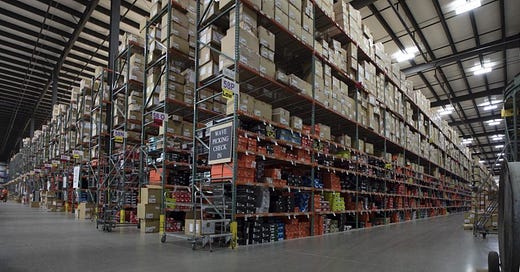Inside Foot Locker’s Bold Supply Chain Transformation: Lacing Up for Omnichannel Success
Foot Locker’s strategy blends inventory accuracy, vendor collaboration, and strategic technology to keep pace with fast-changing sneaker trends.
If you've been following retail supply chains as long as I have, you know how tough it is to adapt quickly enough to stay relevant . Inventory nightmares, fragmented vendor relationships, outdated tech - you name it, I've seen it. So when Foot Locker shared details on their recent transformation journey, I paid attention - close attention.
Foot Locker’s companywide "Lace Up" initiative isn't just another fluffy corporate slogan. It’s an aggressive, multi-year strategy designed to completely modernize how Foot Locker manages inventory, collaborates with vendors, and serves customers—both digitally and in-store. Recently at RILA’s LINK 2025 conference, their leadership detailed exactly how supply chain enhancements have been central to driving this evolution forward.
Inventory Accuracy: The Omnichannel Heartbeat
Elliott Rodgers, EVP and COO at Foot Locker, emphasized a point many retailers overlook: inventory management isn't just operational - it’s foundational. Inventory is literally the heartbeat of omnichannel retailing. If that heartbeat isn’t stable, your whole customer experience flatlines.
Given Foot Locker’s reliance on trendy sneakers, inventory poses unique challenges. Sneaker trends change rapidly - what’s hot today might not be tomorrow, leaving trapped or aging inventory a serious risk. Kristin Bauer, Foot Locker’s Chief Supply Chain Officer, openly admits it's a tough balance. Much of their stock is allocated, meaning supply isn't limitless. That's why precision in inventory forecasting and real-time visibility across every item and location have become non-negotiable.
Their proactive shift to leverage retail store inventory as part of their omnichannel fulfillment was particularly smart. By fulfilling online orders directly from stores, Foot Locker significantly reduced canceled or rejected orders in 2024 - crucial for customer satisfaction. Bauer herself noted, “For us, fulfilling digital orders from store inventory isn’t merely about warehouse capacity; it's about leveraging inventory intelligently.”
And now, to elevate inventory precision even further, Foot Locker is implementing RFID technology in distribution centers. This strategic move - enabled because much of their merchandise already arrives RFID-tagged from suppliers - is an impactful yet cost-effective way to gain deeper insights into inventory flows from receiving to shipping.
Strengthening Vendor Relationships: Less is More
Another fascinating aspect of Foot Locker's approach is its intense focus on supplier relationships. Rather than juggling thousands of vendors, Foot Locker strategically partners with fewer, carefully selected brands. In 2024, they significantly ramped up efforts to foster stronger, upstream vendor collaboration.
Bauer explained how this strategic supplier collaboration yielded immediate, meaningful outcomes: “Providing improved forecast accuracy and sharing deeper upstream data with key vendors allowed both sides better visibility into buying patterns, allocation, and consumer trends. It dramatically improved buying accuracy.”
These tighter, strategic relationships aren't just nice-to-have - they’re essential. Sneakers, after all, are highly trend-sensitive. The ability to anticipate demand shifts by collaborating closely with trusted vendors means fewer markdowns, less trapped stock, and ultimately better margins.
Cross-Functional Collaboration: Breaking Down Silos
Foot Locker didn't just focus externally; they also looked inward, revolutionizing internal collaboration. Traditionally, retail companies operate within departmental silos: procurement, supply chain, marketing - each doing their own thing, sometimes misaligned.
Rodgers emphasized that Foot Locker intentionally pivoted toward cross-functional integration, orienting all activities around the customer experience. “We're now united behind a common North Star - delivering exceptional customer experiences—rather than individual departmental goals,” he said.
Introducing Integrated Business Planning (IBP) further catalyzed these cross-functional conversations. Bauer highlighted how IBP drove entirely new dialogues within her supply chain team, shifting the mindset from purely operational to customer-centric. Decisions aren't isolated within departments anymore; they're made collaboratively, aligning closely with broader company goals.
Accelerating Tech Innovation: Staying Ahead of Trends
Perhaps the most intriguing change at Foot Locker is its renewed dedication to rapidly evolving technology adoption. Rather than waiting for slow annual planning cycles, the company now maintains an internal "tech council," meeting quarterly to consistently evaluate their technology stack.
Their adoption of a leaner product operating model - with smaller, nimble teams deploying features and new capabilities—has allowed them to quickly respond to the shifting consumer landscape. Rodgers explained this strategy at the LINK conference: “Smaller product teams empowered to innovate have allowed us to deploy new functionality faster, keeping pace with our customers’ demands.”
The early results speak volumes. Foot Locker’s recent launch of six completely redesigned stores (part of their broader Lace Up initiative) integrates physical and digital experiences seamlessly, supported by a revamped mobile app. The initiative has shown clear momentum in enhancing customer interactions across every channel.
A Holistic Approach for Lasting Impact
By blending enhanced inventory accuracy, strategic supplier partnerships, cross-functional integration, and rapid technology adoption, Foot Locker has set itself up to thrive amid volatility and uncertainty.
I’ve seen countless retail supply chain transformations. But Foot Locker’s strategic approach - particularly their aggressive pursuit of inventory accuracy via RFID, vendor transparency, and collaborative planning - is genuinely impressive. It positions them strongly against competitors who are still scrambling to catch up.
But that's just my perspective. What do you think about Foot Locker’s ambitious supply chain strategy? Are RFID integration, stronger vendor collaboration, and customer-centric innovation the keys to future retail success—or are there gaps you see? Drop your comments and join the discussion below!





